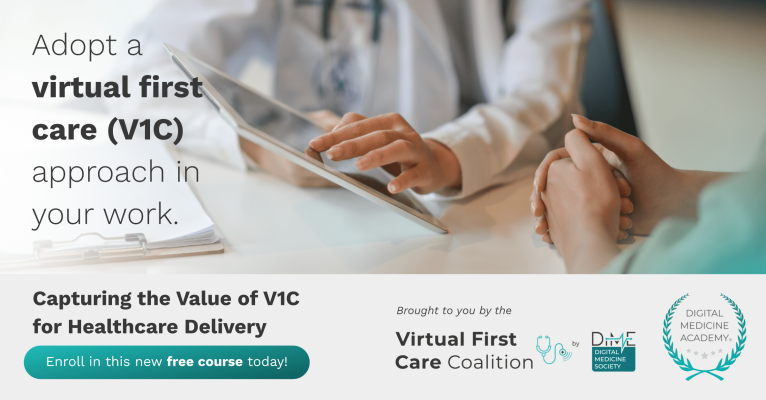
Redefining healthcare: Embracing the power of Virtual First Care (V1C)
The global virtual care market is now valued at nearly $80 billion by 2032. To succeed in today’s evolving healthcare, healthcare stakeholders must strategically incorporate digital interactions into the system, ensuring that their policies and regulations evolve with technological advancements.
The Virtual First Care (V1C) Coalition by the Digital Medicine Society (DiMe), is at the forefront of this transformation. Our mission is to optimize the healthcare ecosystem for the digital age, enhancing outcomes, access, and patient-centered care through V1C.
What is V1C?
V1C refers to medical care primarily accessed through digital means, guided by a clinician, and integrated into a person’s daily life. This approach includes asynchronous communication with care teams, remote monitoring, at-home diagnostics, and health education. Unlike traditional telemedicine, which focuses on virtual appointments as an alternative to in-person visits, V1C is a comprehensive care model that seamlessly integrates various virtual components to enhance patient care.
For example, imagine you are a patient with a chronic condition like heart disease. Your clinician, whom you regularly visit, has guided and monitored you closely during in-person appointments.
Then, one day, you’re at home when you begin to feel a sudden increase in your heart rate. You call your clinician to book a telehealth appointment to adjust your medication dose virtually. From there, your clinician provides you with a remote patient monitoring tool (RPM) to monitor your heart rate remotely to prevent a potential emergency. You’ve received immediate, personalized care with support services.
You will continue to receive long-term follow-up, both in the clinic and virtually, but more importantly, you are receiving your care flexibly, when you need it, and where you are the most comfortable – that’s V1C.
Accelerating the adoption of V1C
The COVID-19 pandemic accelerated the adoption of virtual care modalities across the U.S. healthcare system out of necessity. However, this shift toward virtual-first interactions is becoming the new normal, driven by increasing patient demand for convenience and accessibility. As a result, many patients are enrolling in V1C platforms for primary, specialty, and urgent care services.
V1C has generated sustainable health outcomes and economic efficiencies across diverse healthcare domains, including:
- Members with elevated A1C (over or equal to 8%) at baseline experienced an average 1.8-point decline in A1C over 12 months.
- A 55.3% reduction in avoidable emergency department utilization for migraine headaches.
- Annual cost savings of $6,724 per member for GI-related costs and $10,292 per member for all-cause costs.
These outcomes indicate that this care modality can provide scalable, personalized care that addresses unmet needs and enhances accessibility. Yet, effectively integrating V1C into the current healthcare delivery landscape requires equipping stakeholders with a deep understanding of V1C to ensure the governing policies and processes of implementing these services position the field for successful adoption.
V1C’s transformative potential
Understanding V1C’s distinction from traditional telemedicine is key to appreciating its potential. V1C allows clinical teams to monitor and care for patients around the clock, regardless of location, breaking down geographical barriers and democratizing healthcare access. This model enables continuous health monitoring, real-time feedback, and personalized care adjustments, resulting in better patient engagement and outcomes.
However, for V1C to realize its full potential, it is crucial to address challenges within the healthcare system. This includes updating policies to support innovation, such as adapting reimbursement rules for virtual services, expanding licensure flexibilities for providers to practice across state lines, and establishing data privacy standards that accommodate remote monitoring technologies. Effective collaboration between V1C providers, health systems, and payors is essential to ensure sustainable access, coverage, and patient engagement.
The future of V1C
V1C offers a promising future for various stakeholders. Health plans can enhance member satisfaction and manage chronic conditions more effectively, while employer groups can promote employee health and reduce healthcare spending. Government agencies can leverage V1C to address access disparities and advance equitable health outcomes, and academic institutions can prepare future healthcare professionals for a digital-first landscape. Patients, in turn, gain more convenient access to care, personalized health management, and improved health outcomes through continuous monitoring and timely interventions.
The V1C Coalition by DiMe is dedicated to ensuring that all individuals, especially underserved populations, have access to high-quality, patient-centered care.
We invite you to join us in shaping the future of healthcare! Then, access our new, free course, “Capturing the Value of V1C for Healthcare Delivery”, and follow us on LinkedIn to learn more about V1C’s core components, its potential to build the next generation of healthcare delivery, and the latest news and updates from the best-in-class industry leaders who make it possible.
Together, we can unlock V1C’s full potential, transform healthcare delivery, and create a more equitable, accessible, and cost-effective system prioritizing patient well-being.

